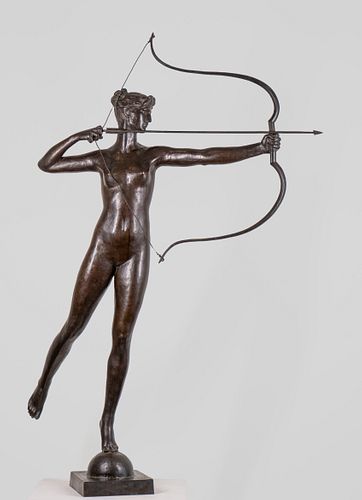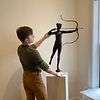Augustus Saint- Gaudens (American 1848-1907) DIANA Bronze
Lot 4
About Seller
Keno Auctions
127 East 69th Street
New York, NY 10021
United States
Keno Auctions is renowned for our expertise in fine and decorative arts. With more than 30 years experience, founder Leigh Keno has established a brilliant team of experts specializing in fine art, furniture, decorative arts and jewelry.
Categories
Estimate:
$200,000 - $400,000
Absentee vs Live bid
Two ways to bid:
- Leave a max absentee bid and the platform will bid on your behalf up to your maximum bid during the live auction.
- Bid live during the auction and your bids will be submitted real-time to the auctioneer.
Bid Increments
| Price | Bid Increment |
|---|---|
| $0 | $25 |
| $100 | $100 |
| $2,000 | $250 |
| $5,000 | $500 |
| $30,000 | $2,500 |
| $50,000 | $5,000 |
| $100,000 | $10,000 |
| $500,000 | $10,000 |
| $1,000,000 | $10,000 |
About Auction
By Keno Auctions
Jan 23, 2021
Set Reminder
2021-01-23 13:00:00
2021-01-23 13:00:00
America/New_York
Bidsquare
Bidsquare : Americana and Estates Auction
https://www.bidsquare.com/auctions/keno/americana-and-estates-auction-6312
Keno Auctions Leigh@kenoauctions.com
Keno Auctions Leigh@kenoauctions.com
- Lot Description
Augustus Saint-Gaudens
(American, 1848 - 1907)
DIANA
Aubry Brothers bronze foundry, New York, ca. 1895
Bronze with dark brown patina
The figure holding a large recurve bow with arrow and perched upon a hemisphere and integral square plinth
Height: of the figure: 31 in.
Overall Height: 38 ⅞ in.
Depth: from the tip of the arrow to the extended foot: approx. 27 in.
INSCRIPTIONS:
Incised at bottom edge of integral half-orb: "AUGUSTUS SAINT-GAUDENS"
Incised at bottom edge of integral square bronze plinth: "COPYRIGHT·BY·A·SAINT-GAUDENS·M·D·C·C·C·X·C·V."
PROVENANCE:
Frank P. Ewing, Wilmington, Delaware
Purchased in 1959 by Constantine "Gus" Sclavos (1896-1985) owner of Glasgow Arms restaurant, Glasgow, Delaware. (The original March 3,1959 receipt for sale of Diana from Ewing to Constantine Sclavos will accompany this work)
By descent to his daughter Mary Sclavos Murphy (1925-2020), Elkton, Delaware
Thence by descent to the present owners
NOTE:
Prior to the discovery of the present "Diana of the Tower'' there were just six examples of the 31-inch (height of figure alone) reductions known. This newly discovered sculpture is the seventh. Saint Gaudens had these large bronze "reductions'' cast by the Aubry Brothers bronze foundry in downtown Manhattan.
Five of these are referred to in:"The Work of Augustus Saint-Gaudens" by John H. Dryfhout, (University Press of New England, Hanover and London, 1982) and one of the 31 inch Diana reductions is shown (Plate 154-5):
1. Brooklyn Museum, Brooklyn, NY (arrow missing) #23.255
2. Walker Cain Associates (formerly McKim, Mead & White - photo documentation missing)
3. Chesterwood National Trust; for Historic Preservation
4. Indianapolis Museum of Art. Indianapolis, IN. #17.254 gift of the Jennie Ormsby pupils in 1917
5. Private collection, Washington, D.C
6. Example by New York Art Dealers Conner-Rosenkrantz (descended in family of owner who received it c. 1910 as a gift)
Suzanne Hinman, in her recent (2019) well-researched book "The Grandest Madison Square Garden, Art, Scandal and Architecture in Gilded Age New York, (Syracuse University Press, Syracuse, NY, 2019, pp. 295-296) explains:
"With counterfeit plaster versions of "Diana" in faked bronze finish being hawked in front of Madison Square Garden for seventy-five cents (1) Augustus Saint-Gaudens registered US copyright number 6782AA on the reduced figure of Diana in January 1895. A variety of versions would follow, but he made certain that each bore a copyright mark, incised by hand until 1901 when it was replaced by a small stamp or plug, either cast separately and inserted or cast directly with the model.(2)
For the next iteration, a large "Diana" measuring 31 inches in height was cast by the French-born brothers Ernest and Charles Aubry at the Lorme-Aubry bronze foundry in downtown New York in 1895. Holding a heavy recurve bow with a large, flat articulated riser, this "Diana" now stood on a half sphere set on a square plinth incised with the copyright symbol. Some were stamped with the words "Augustus Saint-Gaudens 1895" (3) while on others the same date was expressed in Roman numerals (4). This edition was sold at both H. Wunderlich and Co. and the Frederick Keppel Gallery in New York, as well as in Boston at Doll and Richards Fine Arts and the silver and fancy goods store Bigelow, Kennard and Co. (5) There was also an extra-large version, 41 inches, high, of which Charles McKim may have been the first owner.(6) His unstamped piece appears to have been followed in production by those stamped 1895, 1899, and 1905 and bearing the title "Diana of the Tower" on the base. (7) "
FOOTNOTES FOR HINMAN'S EXCERPT ABOVE:
(1) "Casts and Images Made in Plaster," New York Herald, July 2, 1893. A bronze finish was commonly faked by applying a coat of thin shellac and then a layer of dull brown paint rubbed with a greenish bronze powder until the entire surface was evenly coated. "How to Bronze Plaster Casts," New York Evening World, May 19, 1893.
(2) US copyright SGNHS: Dryfhout, "Diana," 184
(3) Brooklyn Museum of Art #23.255
(4) Chesterwood National Trust for Historic Preservation, purchased at auction in the 1920s; in #1977.55 in the collection of the Currier Museum of Art , the sphere sits directly on a marble plinth.
(5) ASG to Augustus Saint-Gaudens, Aug, 3, box 28:5, Papers of ASG; ASG to Doll & Richards, Nov 28, 1899, box 5:3, Papers of ASG, "The Fine Arts," Boston Evening Transcript, Jan. 31, 1899.
(6) Metropolitan Museum of Art, New York, #1908:37
(7) See Brooklyn Museum #23.255; Sheldon Museum of Art, Univ. of Nebraska #1985.N-676; Indianapolis Museum of Art #17.254, respectively.
For an excellent, scholarly discussion of Saint-Gaudens's Diana sculptures by Thayer Tolles, the Marcia F. Vilcek Curator of American Paintings and Sculpture at the Metropolitan Museum of Art, please see "Augustus Saint-Gaudens in the Metropolitan Museum of Art", (Yale University Press, New Haven and London, 2009) pp. 31-35. Includes discussion of Fig. 42, p. 34, the "Diana" sculpture in the Metropolitan Museum of Art.
The monumental version of the present sculpture was conceived as a weathervane for the tower of Stanford White's Madison Square Garden in 1886. A famed architect with the successful firm McKim, Mead and White, White was also the original owner of a smaller (21 inch) work, given to him by the artist shortly after its casting. Unfortunately, Saint-Gaudens' original eighteen-foot rendition of Diana proved oversized, unwieldy and imbalanced and, in 1892 was removed from Madison Square Garden. The figure was then installed atop the McKim, Mead and White pavilion at the Columbian Exposition, where the lower half was burned in a fire. In 1894, the artist created a second version, thirteen feet high, which was installed atop the Madison Square Garden tower. After Madison Square Garden was demolished in 1925, it was put in storage and is now in the collection of the Philadelphia Museum of Art.
Diana had become so iconic, popular and scandalous that, in 1895 Saint-Gaudens wisely copyrighted the Diana model and, in order to capitalize on its notoriety, produced an edition of reductions in three variations: the first version, with 31-inch figures on a half-orb made at the Aubry Brothers Foundry in New York of which the newly discovered present bronze is the 6th were each cast under Saint-Gaudens strict supervision, with the artist making small changes to each one; the second version were 21-inch figures on a full orb cast in Paris: the third version were 21-inch figures on an orb, balanced on a large tripod base, also made at a Parisian Foundry. The casts vary from edition to edition in details such as the base, sphere, bow and hair.
1st variation: Aubry Brothers foundry, New York
Present Example depicting a 31-inch figure poised on a half-orb upon an integral bronze base; Purchased by Constantine Sclavos in 1959 from Frank Ewing, Wilmington Delaware
2nd variation: E. Gruet Foundeur, Paris
21-inch figure Diana of the Tower balancing on an orb upon a square two tier base at the Nichols House Museum. (missing bronze bow string).
In contrast to the (now seven) known larger 31-inch figure versions, casts of the (⅓ smaller) 21-inch figure size constitute a much more numerous group. The 21 inch "Diana of the Tower'' reductions include those at The Metropolitan Museum of Art (Accession Number: 1985.353, cast by E. Gruet Founder, Paris), "Nichols House Museum, Boston; private collection, Brookline, Massachusetts, [...]; formerly in the Saint-Gaudens family, then with Christie's, New York, in 1983 another cast with Christie's, New York, in 1984; formerly Mrs. Palfrey Perkins, Boston, then with Hirschl and Adler, New York, in I989; Sotheby's, New York, in 1996; and Sotheby's, New York, in 1999; [...] the National Gallery. [...]
Some fifteen bronze casts [of 21-inch Diana on a triangular base are preserved at] the New-York Historical Society, acquired 1977; Cuerease Institute, Tulsa; Williams College Museum of Art, Williamstown, Massachusetts; Childs Gallery, Boston, in 1982/1989; and formerly the Leon Harris collection, then with Shepherd Gallery, New York, in 1990; [...] the Cleveland Museum of Art, acquired 1946; Currier Gallery, Manchester, New Hampshire, acquired 1977; Smith College Museum of Art, Northampton, Massachusetts (cast by Aubrey Brothers Foundry, New York, acquired 1915); Virginia Museum of Fine Arts, Richmond, acquired 1975; New York Life Insurance Company (probably acquired 1925); Sotheby Parke Bernet Inc., New York, in 1975; private collection in Seville, Spain (reported in 1982); by descent in the Adams family, Lincoln, Massachusetts, then with Hirschl & Adler, New York, in 1989; and private collection, New York, then with Christie's, New York, in 1991". Ruth Butler, Suzanne Glover Lindsay, European Sculpture of the Nineteenth Century, Oxford University Press, 2000, p. 463.
The body of the sculpture was modeled by Julia Baird. The face is that of Davida Johnson Clark, Saint-Gaudens' long-time model and mother of his [out of wedlock] son Louis.
Lauretta Dimmick writes, "In 1894 Saint-Gaudens gave his wife as a Christmas gift a 'little' Diana 'to do whatever you please with it.' [apparently, upon learning that her husband was having an affair with the model that posed for Diana, she smashed it]. In January 1895 he obtained a copyright for the reduced Diana. An edition of 31-inch-high figures was cast by the Aubry Brothers foundry in New York. For this version (Brooklyn Museum of Art) Diana balances on a hemisphere and holds an arrow and a strung bow that is heavier than in subsequent versions. A 21-inch figure, gracefully poised on an orb upon a two-tiered base, was cast as early as 1894 at the Gruet foundry in Paris... A third version, also a 21-inch figure, was this version produced when Saint-Gaudens was in Paris in 1899. For this version, he remodeled the hair and the bow and altered the base so that the sphere rests on a tripod decorated with winged griffins, scrollwork, and rosettes." (from American Sculpture in The Metropolitan Museum of Art, vol. 1, New York, 1999, p. 309.) Apparently Saint-Gaudens widow continued to have casts made of this final version long after the artist's death.
Diana is arguably Saint-Gaudens' most celebrated sculpture and exhibits all of the characteristics of the artist's best work. It happens to be the only model of a female nude that the artist ever produced. Diana began as Saint-Gaudens' innovative version of a weathervane. The classically styled Diana which he produced has endured today as his most celebrated sculpture and distinguished him then and now as one of the leading artists in the realm of nineteenth-century American sculpture.A Conservation Report by Steve Tatti of Tatti Conservation of New York:Condition
"The above piece presents in overall good to very good condition. The dark brown patina presents well with a healthy and uniform tone throughout. There are only slight variations on the surface with minor low lights and areas of darkness within recesses. Currently, the surface appears to have an older protective wax coating that is holding up reasonably well, however there is light atmospheric debris which has built up in deeper crevasses. There are two holes at the top side of the base which were added for securing the work and are not original to the fabrication.
The arrow within the figure's hand has been previously repaired at the juncture between the arrow and the proper left hand. This repair was performed using epoxy and a metal sleeve with a corresponding steel pin, which eventually failed. The failed repair was fully removed, and the area of damage cleaned thoroughly. Once purged of contaminates, corresponding holes were drilled at the interior of the arrow shaft on either side of the break to receive a non-ferrous pin to bridge the area. With the juncture bridged, the area was soldered and reshaped to contour.
The back end of the arrow which fits into the proper right hand appeared to have been truncated during a prior repair and there was no longer a nock in the arrow. This element was added to ensure proper orientation and stabilization during exhibition.
Lastly, the steel pin in the proper left hand to secure the arrow was removed and the hole was infilled with a hard wax filler. The arrow then received a new non-ferrous mounting pin, and a corresponding hole was added to the hand area to receive and secure the arrow.
Finally, both ends of the bow were removed and realigned to better correspond with one another. These two elements are not perfectly symmetrically, but larger deformations were corrected and improving the overall presentation. Additionally, while the bow ends were removed, a streel mounting pin was removed from the top half of the proper left hand and replaced with a non-ferrous threaded rod.
After all the structural repairs were completed, the bow was restrung to tension and areas of repair were color corrected to match."
Keno Auctions:
Retains its original surface with a warm reddish-brown patina. The bow, its twisted bronze bow-string, as well as the arrow, are all original. The forward-most four inches of the shaft of the arrow was broken at its juncture with the bow. The former owner (the late Mary Sclavos Murphy, co-owner of the Glasgow Arms Restaurant) explained in a videotaped interview with LRK how the arrow shaft with arrow head extending forward from the bow was snapped off as the result of a vehicle crashing into the restaurant circa 1975. The original broken piece was quickly located and reattached with the help of a metal sleeve). Two holes were drilled into the rectangular base c.1960 by Mr. Sclavos in order to attach it to a black-painted wooden block for the purpose of making the sculpture more stable for display in a restaurant environment. The block was removed from the base by Keno Auctions but will accompany the sculpture when sold.
Please note: Any condition statement is given as a courtesy to the client but is only an opinion - however conscientiously undertaken and offered- and should not be treated as a statement of fact. Keno Auctions shall have no responsibility for any error or omission. The absence of a condition statement does not imply that the lot is in perfect condition or completely free from age-appropriate wear and tear or imperfections of any type.
- Shipping Info
-
Buyer Pays Shipping Cost
-
- Buyer's Premium



 EUR
EUR CAD
CAD AUD
AUD GBP
GBP MXN
MXN HKD
HKD CNY
CNY MYR
MYR SEK
SEK SGD
SGD CHF
CHF THB
THB



































